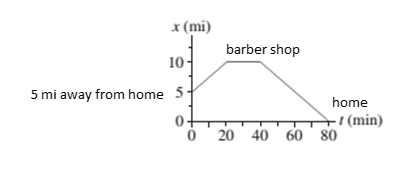
Concept explainers
For Questions 1 through 3, interpret the position graph given in each figure by writing a very short “story” of what is happening. Be creative! Have characters and situations! Simply saying that “a car moves 100 meters to the right” doesn’t qualify as a story. Your stories should make specific reference to information you obtain from the graph, such as distance moved or time elapsed.
Short story which interprets the graph.
Explanation of Solution
Given:
Distance versus time graph.
Paul is 5 mi away from the home at a car shop. He traveled to the barber shop and covered the distance of 5 mi, in further 20 mins he reached a barber shop, where he had a haircut in 20 min. Then, he traveled back home with the same speed and covered 10mi in 40 mins.
Consider the figure of the movement indicating the movement of Paul,

Figure.1
Conclusion:
This figure indicates the movement of Paul, and variation in distance with respect to time.
Want to see more full solutions like this?
Chapter 2 Solutions
PHYS 212 FOR SCI+ENG W/MAST PHYS >ICP<
Additional Science Textbook Solutions
Anatomy & Physiology (6th Edition)
Human Biology: Concepts and Current Issues (8th Edition)
Cosmic Perspective Fundamentals
Campbell Essential Biology with Physiology (5th Edition)
Genetic Analysis: An Integrated Approach (3rd Edition)
Human Physiology: An Integrated Approach (8th Edition)
- According to your book "normal" human body temperature is considered to be ________? Select one: a. none of these b. 98.6°C c. 37°C d. 100°Carrow_forwardProblem Seven. A football receiver running straight downfield at 5.60 m/s is 11.5 m in front of the quarterback when a pass is thrown downfield at an angle of 35.0° above the horizon. 8.) If the receiver never changes speed and the ball is caught at the same height from which it was thrown, find the distance between the quarterback and the receiver when the catch is made. (A) 21.3 (B) 17.8 (C) 18.8 (D) 19.9 (E) 67.5arrow_forwardWhen two bar magnets are near each other, the north pole of one of the magnets experiences what type of force from the other magnet? 1. both an attractive force and a repulsive force 2. a Coulomb force 3. only an attractive force 4. only a repulsive forcearrow_forward
- What can be said about the electric force between two charged particles? It varies as 1/r. It depends only on the magnitudes of the charges. It is much, much greater than the attractive gravitational force. It is repulsive for unlike charges.arrow_forwardA piece of copper originally 305mm long is pulled in tension with a stress of 276MPa. If the deformation is elastic, what will be the resultant elongation. E for copper is 110Gpaarrow_forwardPlease solve and answer the problem correctly please. Be sure to give explanations on each step and write neatly please. Thank you!!arrow_forward
- In the figures, the masses are hung from an elevator ceiling. Assume the velocity of the elevator is constant. Find the tensions in the ropes (in N) for each case. Note that 0₁ = 35.0°, 0₂ = 55.0°, 03 = 60.0°, m₁ = 3.00 kg, and m2 = 7.00 kg. (Due to the nature of this problem, do not use rounded intermediate values-including answers submitted in WebAssign-in your calculations.) (a) Τι WY NY MY T3 e₁ T₁ = N = N = N (b) 18 Τι = Τι T3 = || || || = T T Ts m₂ N N N 02 T₂ T3 m₁arrow_forwardYou are working with a movie director and investigating a scene with a cowboy sliding off a tree limb and falling onto the saddle of a moving horse. The distance of the fall is several meters, and the calculation shows a high probability of injury to the cowboy from the stunt. Let's look at a simpler situation. Suppose the director asks you to have the cowboy step off a platform 2.55 m off the ground and land on his feet on the ground. The cowboy keeps his legs straight as he falls, but then bends at the knees as soon as he touches the ground. This allows the center of mass of his body to move through a distance of 0.660 m before his body comes to rest. (Center of mass will be formally defined in Linear Momentum and Collisions.) You assume this motion to be under constant acceleration of the center of mass of his body. To assess the degree of danger to the cowboy in this stunt, you wish to calculate the average force upward on his body from the ground, as a multiple of the cowboy's…arrow_forwardA box of mass m = 2.00 kg is released from rest at the top of an inclined plane as seen in the figure. The box starts out at height h =0.200 m above the top of the table, the table height is H = 2.00 m, and 0 = 41.0°. H m (a) What is the acceleration (in m/s²) of the box while it slides down the incline? m/s² (b) What is the speed (in m/s) of the box when it leaves the incline? m/s (c) At what horizontal distance (in m) from the end of the table will the box hit the ground? m (d) How long (in s) from when the box is released does it hit the ground? S (e) Does the box's mass affect any of your above answers? Yes Noarrow_forward
- (a) A sphere made of rubber has a density of 0.940 g/cm³ and a radius of 7.00 cm. It falls through air of density 1.20 kg/m³ and has a drag coefficient of 0.500. What is its terminal speed (in m/s)? m/s (b) From what height (in m) would the sphere have to be dropped to reach this speed if it fell without air resistance? marrow_forwardThe systems shown below are in equilibrium. If the spring scales are calibrated in newtons, what do they read? Ignore the masses of the pulleys and strings and assume the pulleys and the incline are frictionless. (Let m = 2.19 kg and € = 29.0°.) scale in (a) N N scale in (b) scale in (c) N scale in (d) N a C m m m m m b d m Ꮎarrow_forwardAn elevator car has two equal masses attached to the ceiling as shown. (Assume m = 3.10 kg.) m m T₁ T2 (a) The elevator ascends with an acceleration of magnitude 2.00 m/s². What are the tensions in the two strings? (Enter your answers in N.) = N T₁ Τι = N (b) The maximum tension the strings can withstand is 78.8 N. What is the maximum acceleration of the elevator so that a string does not break? (Enter the magnitude in m/s².) m/s²arrow_forward
 Physics for Scientists and Engineers with Modern ...PhysicsISBN:9781337553292Author:Raymond A. Serway, John W. JewettPublisher:Cengage Learning
Physics for Scientists and Engineers with Modern ...PhysicsISBN:9781337553292Author:Raymond A. Serway, John W. JewettPublisher:Cengage Learning Glencoe Physics: Principles and Problems, Student...PhysicsISBN:9780078807213Author:Paul W. ZitzewitzPublisher:Glencoe/McGraw-Hill
Glencoe Physics: Principles and Problems, Student...PhysicsISBN:9780078807213Author:Paul W. ZitzewitzPublisher:Glencoe/McGraw-Hill Principles of Physics: A Calculus-Based TextPhysicsISBN:9781133104261Author:Raymond A. Serway, John W. JewettPublisher:Cengage Learning
Principles of Physics: A Calculus-Based TextPhysicsISBN:9781133104261Author:Raymond A. Serway, John W. JewettPublisher:Cengage Learning University Physics Volume 1PhysicsISBN:9781938168277Author:William Moebs, Samuel J. Ling, Jeff SannyPublisher:OpenStax - Rice University
University Physics Volume 1PhysicsISBN:9781938168277Author:William Moebs, Samuel J. Ling, Jeff SannyPublisher:OpenStax - Rice University Physics for Scientists and Engineers: Foundations...PhysicsISBN:9781133939146Author:Katz, Debora M.Publisher:Cengage Learning
Physics for Scientists and Engineers: Foundations...PhysicsISBN:9781133939146Author:Katz, Debora M.Publisher:Cengage Learning Physics for Scientists and EngineersPhysicsISBN:9781337553278Author:Raymond A. Serway, John W. JewettPublisher:Cengage Learning
Physics for Scientists and EngineersPhysicsISBN:9781337553278Author:Raymond A. Serway, John W. JewettPublisher:Cengage Learning





